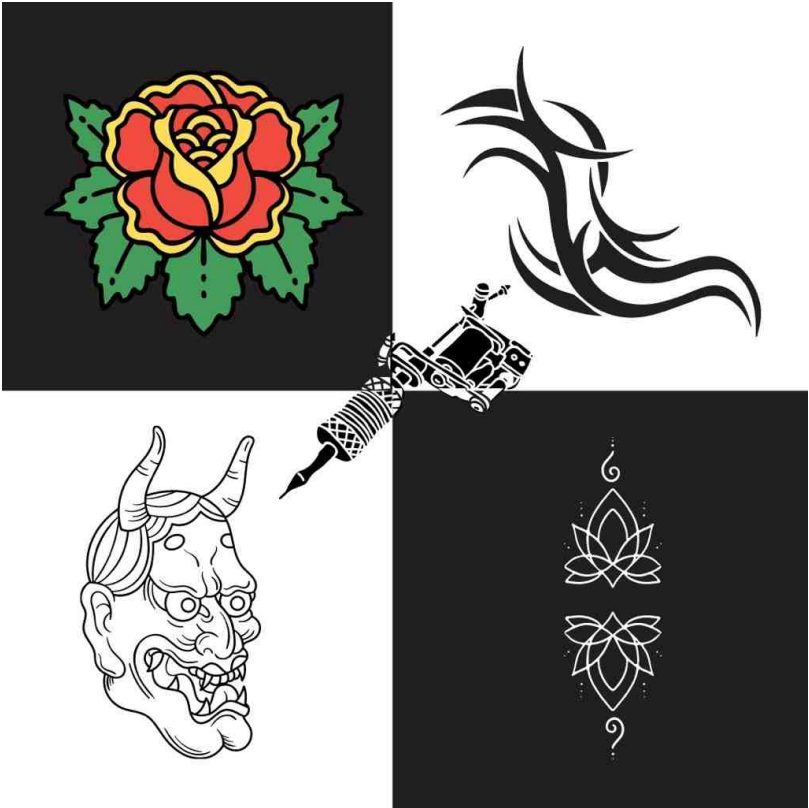By Cliona Hickey
Edited by Maeve Bouchez
The history of tattoos is long, complex, and full of stories of stigma. Today, if you want to get a job in healthcare, aviation, financial services, law enforcement or teaching, you’d better not have a visible tattoo. In China, it is illegal to show tattoos on television, and Japanese public pools and spas ban tattoos altogether. What if I told you that Czar Nicholas, Winston Churchill, Joseph Stalin, and Thomas Edison all had tattoos. In the 1800s, it was estimated that 1 in 5 members of the nobility were inked.
The history of tattooing goes back to 3370 BC. Otzi the Iceman, a mummy found in the Austrian alps, was found with 61 markings on his body. Even better-preserved Egyptian mummies from a similar historical period were discovered bearing tattoos. In fact, there are mummies from 49 distinct parts of the world with tattoos, which proves that tattooing developed independently in diverse cultures.In the ancient times, indigenous tattoos were done using tree soot, bone, and thorns.

In Pacific Islands such as Samoa, Tahiti and Hawaii, tattoos were often natural symbols, representing spiritual power, status and sometimes indicated where you were from. In 1778, Captain James Cook discovered these islands and recorded their tattooing practices; some of his crew even got tattoos themselves. A few years later however, colonizers banned them to force Pacific inhabitants to assimilate into Western culture. Luckily, a small amount of tattoo culture was able to be preserved, and today, many Pacific Islanders, especially women, are reclaiming their history by starting to get inked once again.
In Japanese traditions, Irezumi tattoos almost cover the entire body and can take years to complete. These are beautiful designs, portraying Japanese folk heroes and powerful natural elements. In Japan, tattoos are highly taboo and are banned from public pools and baths. This is for two reasons: up until the 17th century, criminals were given tattoos on their faces and arms as punishment for their crimes, although this ended when criminals began using decorative ones to hide those marks. Also, tattooing was made illegal in the 18th century, meaning that only criminals got tattoos.
Before tattooing became mainstream, people who got tattoos were sailors, criminals, and circus freaks. Sailors would go to tattoo shops (which were often barber shops as well) around the world and pick a tattoo from a selection of stencils (there were no custom tattoos). These tattoos told the story of where they had traveled to, or were status symbols: for example, a sailor got a swallow for every 5,000 nautical miles he travelled, which at the time, was very tough. Therefore, tattoos are often autobiographical and are supposed to have meaning. Simultaneously, a popular form of entertainment was freak shows. People would pay to look at exhibitions such as exotic animals, fetuses in jars, people with abnormalities and people covered in colorful tattoos. Although these were highly dehumanizing, they helped introduce the art of tattoos. Together, these practices resulted in a style called ‘American Traditional’ which uses vivid colors, minimal shading, and strong outlines.
In the last ten years, a fun, contemporary style of tattooing has emerged, called ‘ignorant tattooing’. If you see someone with a tattoo of a pizza or a skateboard, this is it. They are done in a simple lo-fi style and are purposefully meaningless. They are a rejection of the idea that tattoos should be profound and permanent. A few factors have allowed this style to thrive; firstly, tattoo machines are now available for sale online so anyone can buy one. The fact that everyone is doing ignorant style tattoos makes this style simpler, as not everyone has the skills to do complex tattoo work. In the mid 2010s, Instagram had a massive impact on the evolution of both minimalist and ignorant tattoo styles. It gave people the means to share their tattoos, give inspiration, and connect with others throughout the global tattoo community.
I feel we can confidently say that tattoos are here to stay, as humans, we will always want to tell our stories through artwork, whether it be on our bodies or not. The number of people getting tattoos is increasing due to better hygiene standards and the minimization of stigmas. This is a good thing, because tattoos can improve your self-esteem and sense of identity, and I suppose it is not the end of the world if you end up having to remove it.
